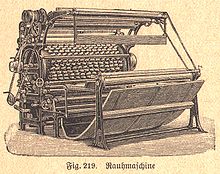Scratching (tool)
Scratching , also known as carding , is used to roughen fabrics made of wool and cotton , especially in cloth-making . It is a final refinement process in the textile industry , which gives the goods a softer feel and greater thermal insulation.
Since around the beginning of the 20th century, they have consisted of wire hooks mounted on leather cords . Before and z. Even today (e.g. in the Lodenwalker company ) the fruit stands of the weaver thistle were still used. Due to this use, the so-called weaver card (cardendistel, weaver thistle) was the guild symbol of the cloth makers.
So that the fabric is not torn when roughening, but only has a fluffy surface structure, either the rough scraper (carding brush) is rolled over the textile by hand or the textile is pulled by rotating scrapers.
history


The trade in Flemish cloths carried out in Aachen also promoted the cloth and needle manufacture there . A second metal product , namely scratches, was added in the 17th century . Previously, a number of seed heads of were carding thistle along pierces and side by side and one behind the other mounted in an axis of rotation on a device that has been passed over the wool fabric, with portions of the threads by the mandrel-like are plucked out, but resilient tips of the dried fruit object and a pile form . After some use, the tips of the thorns are worn out and the fruit heads need to be replaced. The natural thorns were gradually replaced by a wire made from brass , iron and steel . The finishing and grinding of the scratching teeth ensured the quality of the scratches . This was the technical work of the regulators . The work in the grinding shop was life-threatening until the introduction of a dust extraction system. The leather straps were mainly made by tanneries in Belgium . Ambrosius Dubusc's machine marked the beginning of production mechanization. At the beginning of the 19th century, Johann Uhle in Aachen developed a scraping machine that automated the manual use of metal wires. The production of scratching wires in the 19th century was based on the English model.
The needle-tipped leather band scrapers were a special product of the Aachen metal industry until the 20th century. In 1912 there were still seven scratching factories in Aachen. The oldest scratch manufacturer in Aachen was the company operating in the Wylre'schen Hof of the Heusch family : August Heusch & Söhne , the last, Eduard Schwartz GmbH , closed at the end of the 1980s. In 1989 the item description was: "Rough band, 22.5 mm wide, round band in 3-ply fabric with a foam rubber sheet."
The most traditional of these companies was the Aachener Kratzenfabrik Cassalette , which was founded in 1822 by Peter Joseph Cassalette and remained in family ownership for three generations. The former palace of this family, the Villa Cassalette , still bears witness to the success of this branch of industry.
Scraping machines

According to a similar principle, but planned for the later processing of entire lengths of fabric, a universal roughing machine was developed in Saxony by the Gematex company from Aue, among others , which was equipped with 24 rotating roughing rollers. This invention forms the basis of all drum raising machines that exist today. “Tambour” is understood to mean elongated rolls that rotate around their longitudinal axis. The improved variant, the beltless ball-bearing scraping machine, was particularly successful on the market. These cloth-raising machines were used as a textile finishing machine to roughen the surface of a continuous web of textile fabric with the help of scratching rollers, which were now covered with brushes instead of needles. In order to avoid clogging of the scraper rollers with fiber residues, they were continuously cleaned with cleaning rollers.

List of roughened fabrics
Individual evidence
- ^ Kratzen Johann Uhle lived in Königstrasse 29 in 1877: "Machine factory, scratching machines and steam engines (Proc. L. vom Hofe)". In: Aachen address book. 1877.
- ↑ Gematex anniversary page
literature
- Peter Johannes Droste , Michael Käding (ed.): Made in Aachen. Contributions to the regional technical, economic and social history. Association for regional technical, economic and social history "HISTECH" eV, Aachen 2000. ( Made in Aachen 1)
- Hartmut Schainberg: The Belgian influence on early industrialization in the Aachen area, approx. 1820-1860. Inaugural dissertation to obtain the degree of Doctor of Philosophy in Faculty III (History, Political Science, Classical Archeology, Art History, Egyptology, Papyrology). Trier 1997.
- Publication The new generation of electronic card wire raising machines. Fa Textima, Aue 1993.

